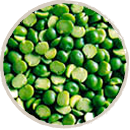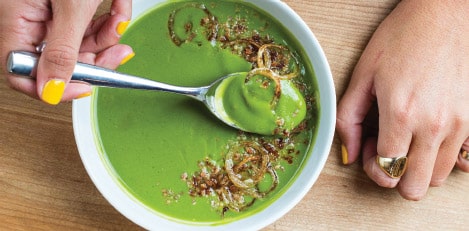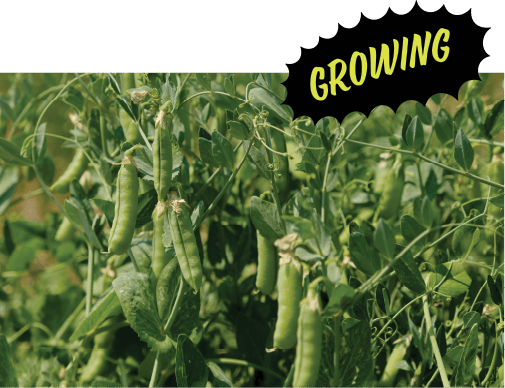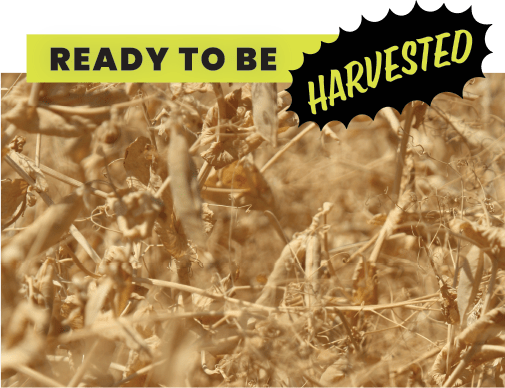Dry Peas

Known for their vibrant yellow and green coloring, dry peas are one of the most surprisingly versatile members of the pulse family (lentils, chickpeas, dry beans, and peas). Typically recognized for their namesake dish – split pea soup – dry peas are harvested dry (unlike fresh green peas), come in both split and whole form, and are often used in a variety of products, including protein powders and plant-based milks. Unlike their pulse cousins, beans and chickpeas, split peas do not require pre-soaking before cooking, making them a just as sustainable and delicious – but even faster – way to get your recommended 1 ½ cup of pulses per week.





This pulse is not only affordable and easy to prepare, but split peas are also extremely nutrient-dense. Split peas are low in fat, a good source of protein, and they are a great source of fiber, manganese, potassium, and magnesium. The USDA recommends a weekly serving of 1 ½ cups of pulses as part of a healthy eating pattern, and dry peas are a simple go-to for meeting this recommendation.
Nutrition Facts
PER HALF-CUP COOKED SERVING
| Dry Peas | Split Green | Split Yellow | Whole Green | Whole Yellow |
| Calories | 115 | 115 | 115 | 115 |
| Total Fat | <0.5g | <0.5g | <0.5g | <0.5g |
| Sodium | <2mg | <2mg | <2mg | <2mg |
| Carbs | 21g | 21g | 21g | 21g |
| Fiber | 8g | 8g | 8g | 8g |
| Protein | 8g | 8g | 8g | 8g |
| Iron | 1.3mg | 1.3mg | 1.3mg | 1.3mg |
| Potassium | 355mg | 355mg | 355mg | 355mg |
| Magnesium | 35mg | 35mg | 35mg | 35mg |
| Folate | 64mcg | 64mcg | 64mcg | 64mcg |

Stovetop
- Rinse split peas with water—no need to soak!
- Combine split peas and water, bring to a boil.
For every cup of split peas, use 2 cups of water. - Simmer for 30 minutes.

1/4 cup dry = 1/2 cup cooked
Pressure Cooker / Instant Pot
- Dry split peas do not require pre-soaking.
- Add dry peas and water to the pressure cooker.
For every 1 cup of peas, use 2 cups of water (or ensure the pulses are covered with 2” of water). - Cook on low pressure for 10-15 minutes.
- Let the pressure release naturally.
- Drain and use in a recipe or store in an air-tight container.

Do not fill the pressure cooker more than halfway, as the ingredients will expand.

With plant-based protein and flexitarian diets on the rise, there are more pea-based products on the grocery store shelves than you might expect! Chips, tortillas, snack bars, pasta, and even milk – can all be found in pea-based varieties.
Pea protein is naturally vegan, gluten-free, dairy-free and does not contain any of the top food allergens — peanuts, tree nuts, eggs, fish, shellfish, cow’s milk, wheat, and soy – making it a stellar choice for people with dietary restrictions or food sensitivities.
Looking to incorporate more plant-based protein into your diet? Choosing pea protein powder to blend into smoothies and shakes will give you an easy vegan and allergen-friendly protein boost. Other fun options include stirring pea protein powder into oatmeal, adding it to baked goods like muffins, brownies, or waffles, or mixing it with juice or water for a post-workout beverage!

Add crispy, roasted yellow split peas to soups, salads, stew and more, or enjoy as a unique crunchy snack
Stick with the classic, and make your favorite rendition of comforting split pea soup
Replace half of your usual cheese sauce with yellow split pea puree for a creamy mac n’ cheese with more fiber and less fat
Combine a portion of cooked split peas with ground pork or sausage in main dishes
Cook and toss dry peas with your favorite spices and sauteed veggies for an easy side dish



North America is the leading producer of high-quality pulse crops in the world, including dry peas. Unlike fresh peas, these crops are harvested in their dry form, with planting taking place from winter to early summer, depending on location.
Today, a popular production method for dry peas is called fractionization, in which the starch and protein is separated and used for ingredients such as a protein powder or noodles. In the U.S., consumers are most familiar with green split peas, while pea protein typically comes from the whole, dry yellow peas. Split peas come from whole peas, which are separated into halves through a splitting process after being harvested.
The dry pea can grow in two forms, either indeterminate (i.e., climbing) or determinate (i.e., bush). The pods of the dry pea are about 3 inches long and contain 4 to 9 seeds, which can have a green, yellow, or cream-colored seed coat.



Did you know that split peas, as with all pulses, are so water efficient, that the United Nations declared 2016 as the International Year of Pulses?! Since the world’s growing population will require a 70% increase in agricultural production by 2050, pulses’ low carbon footprint and water and soil efficiency make them the ideal food of the future.

Yellow peas have a more mild and earthy flavor, while their green counterparts have a slightly sweeter flavor.
Dry peas are one of the oldest crops cultivated by human beings, with evidence dating from Neolithic times in Syria, Turkey, and Jordan.
There is speculation that pea soup was served in Denmark as early as the Bronze Age, when dried peas and cabbage became popular for the long winters there.
“Father of genetics” Gregor Mendel used peas as a subject in his genetics studies in the 1860s.
One of the world’s very first instant products was an instant pea soup, invented by Johann Heinrich Grüneberg in Germany.
National Split Pea Soup Week has been celebrated every year in the U.S. since 1969 and always takes place in November.